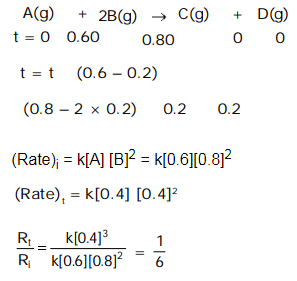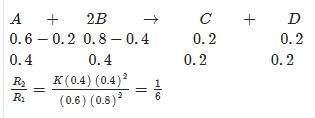Chemistry Exam > Chemistry Questions > The reaction, A(g) + 2B(g) → C(g) + D(g)...
Start Learning for Free
The reaction, A(g) + 2B(g) → C(g) + D(g) is an elementary process. In an experiment, the initial partial pressure of A and B are PA = 0.60 and PB = 0.80 atm. When PC = 0.2 atm the rate of reaction relative to the initial rate is:
- a)1/48
- b)1/24
- c)9/16
- d)1/6
Correct answer is option 'D'. Can you explain this answer?
| FREE This question is part of | Download PDF Attempt this Test |
Verified Answer
The reaction, A(g) + 2B(g) → C(g) + D(g) is an elementary process...

Most Upvoted Answer
The reaction, A(g) + 2B(g) → C(g) + D(g) is an elementary process...
Ans.
After reaction

Free Test
FREE
| Start Free Test |
Community Answer
The reaction, A(g) + 2B(g) → C(g) + D(g) is an elementary process...
The reaction is written as:
A(g) + 2B(g) ⟶ products
This indicates that one molecule of A reacts with two molecules of B to form products. The reactants A and B are both in the gaseous state. The specific products that are formed from this reaction are not mentioned and would depend on the specific reaction conditions and the nature of A and B.
A(g) + 2B(g) ⟶ products
This indicates that one molecule of A reacts with two molecules of B to form products. The reactants A and B are both in the gaseous state. The specific products that are formed from this reaction are not mentioned and would depend on the specific reaction conditions and the nature of A and B.

|
Explore Courses for Chemistry exam
|

|
Similar Chemistry Doubts
The reaction, A(g) + 2B(g) → C(g) + D(g) is an elementary process. In an experiment, the initial partial pressure of A and B are PA = 0.60 and PB = 0.80 atm. When PC = 0.2 atm the rate of reaction relative to the initial rate is: a)1/48 b)1/24 c)9/16 d)1/6Correct answer is option 'D'. Can you explain this answer?
Question Description
The reaction, A(g) + 2B(g) → C(g) + D(g) is an elementary process. In an experiment, the initial partial pressure of A and B are PA = 0.60 and PB = 0.80 atm. When PC = 0.2 atm the rate of reaction relative to the initial rate is: a)1/48 b)1/24 c)9/16 d)1/6Correct answer is option 'D'. Can you explain this answer? for Chemistry 2024 is part of Chemistry preparation. The Question and answers have been prepared according to the Chemistry exam syllabus. Information about The reaction, A(g) + 2B(g) → C(g) + D(g) is an elementary process. In an experiment, the initial partial pressure of A and B are PA = 0.60 and PB = 0.80 atm. When PC = 0.2 atm the rate of reaction relative to the initial rate is: a)1/48 b)1/24 c)9/16 d)1/6Correct answer is option 'D'. Can you explain this answer? covers all topics & solutions for Chemistry 2024 Exam. Find important definitions, questions, meanings, examples, exercises and tests below for The reaction, A(g) + 2B(g) → C(g) + D(g) is an elementary process. In an experiment, the initial partial pressure of A and B are PA = 0.60 and PB = 0.80 atm. When PC = 0.2 atm the rate of reaction relative to the initial rate is: a)1/48 b)1/24 c)9/16 d)1/6Correct answer is option 'D'. Can you explain this answer?.
The reaction, A(g) + 2B(g) → C(g) + D(g) is an elementary process. In an experiment, the initial partial pressure of A and B are PA = 0.60 and PB = 0.80 atm. When PC = 0.2 atm the rate of reaction relative to the initial rate is: a)1/48 b)1/24 c)9/16 d)1/6Correct answer is option 'D'. Can you explain this answer? for Chemistry 2024 is part of Chemistry preparation. The Question and answers have been prepared according to the Chemistry exam syllabus. Information about The reaction, A(g) + 2B(g) → C(g) + D(g) is an elementary process. In an experiment, the initial partial pressure of A and B are PA = 0.60 and PB = 0.80 atm. When PC = 0.2 atm the rate of reaction relative to the initial rate is: a)1/48 b)1/24 c)9/16 d)1/6Correct answer is option 'D'. Can you explain this answer? covers all topics & solutions for Chemistry 2024 Exam. Find important definitions, questions, meanings, examples, exercises and tests below for The reaction, A(g) + 2B(g) → C(g) + D(g) is an elementary process. In an experiment, the initial partial pressure of A and B are PA = 0.60 and PB = 0.80 atm. When PC = 0.2 atm the rate of reaction relative to the initial rate is: a)1/48 b)1/24 c)9/16 d)1/6Correct answer is option 'D'. Can you explain this answer?.
Solutions for The reaction, A(g) + 2B(g) → C(g) + D(g) is an elementary process. In an experiment, the initial partial pressure of A and B are PA = 0.60 and PB = 0.80 atm. When PC = 0.2 atm the rate of reaction relative to the initial rate is: a)1/48 b)1/24 c)9/16 d)1/6Correct answer is option 'D'. Can you explain this answer? in English & in Hindi are available as part of our courses for Chemistry.
Download more important topics, notes, lectures and mock test series for Chemistry Exam by signing up for free.
Here you can find the meaning of The reaction, A(g) + 2B(g) → C(g) + D(g) is an elementary process. In an experiment, the initial partial pressure of A and B are PA = 0.60 and PB = 0.80 atm. When PC = 0.2 atm the rate of reaction relative to the initial rate is: a)1/48 b)1/24 c)9/16 d)1/6Correct answer is option 'D'. Can you explain this answer? defined & explained in the simplest way possible. Besides giving the explanation of
The reaction, A(g) + 2B(g) → C(g) + D(g) is an elementary process. In an experiment, the initial partial pressure of A and B are PA = 0.60 and PB = 0.80 atm. When PC = 0.2 atm the rate of reaction relative to the initial rate is: a)1/48 b)1/24 c)9/16 d)1/6Correct answer is option 'D'. Can you explain this answer?, a detailed solution for The reaction, A(g) + 2B(g) → C(g) + D(g) is an elementary process. In an experiment, the initial partial pressure of A and B are PA = 0.60 and PB = 0.80 atm. When PC = 0.2 atm the rate of reaction relative to the initial rate is: a)1/48 b)1/24 c)9/16 d)1/6Correct answer is option 'D'. Can you explain this answer? has been provided alongside types of The reaction, A(g) + 2B(g) → C(g) + D(g) is an elementary process. In an experiment, the initial partial pressure of A and B are PA = 0.60 and PB = 0.80 atm. When PC = 0.2 atm the rate of reaction relative to the initial rate is: a)1/48 b)1/24 c)9/16 d)1/6Correct answer is option 'D'. Can you explain this answer? theory, EduRev gives you an
ample number of questions to practice The reaction, A(g) + 2B(g) → C(g) + D(g) is an elementary process. In an experiment, the initial partial pressure of A and B are PA = 0.60 and PB = 0.80 atm. When PC = 0.2 atm the rate of reaction relative to the initial rate is: a)1/48 b)1/24 c)9/16 d)1/6Correct answer is option 'D'. Can you explain this answer? tests, examples and also practice Chemistry tests.

|
Explore Courses for Chemistry exam
|

|
Suggested Free Tests
Signup for Free!
Signup to see your scores go up within 7 days! Learn & Practice with 1000+ FREE Notes, Videos & Tests.


















